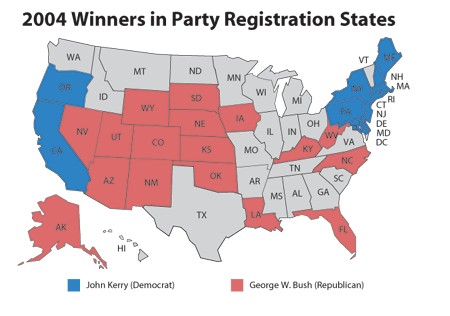A New Electorate In The Making?
By Rhodes Cook
Speculation abounds these days about whether this fall's presidential election will produce a dramatically different electoral map than the virtually static one of the last two contests. Will Colorado and Virginia lead an array of longtime Republican states that might be won this time by Democrat Barack Obama? Or might Michigan and Pennsylvania be in the vanguard of Democratic strongholds picked off by Republican John McCain?
Those are among the more intriguing questions as the 2008 general election campaign heats up. But one thing's for sure: changes in the electoral map require some alterations in the electorate itself. And that seems to be happening.
In the 29 states (plus the District of Columbia) where voter affiliation is kept by party, the Democrats have scored perceptible gains since the presidential election of 2004 while the Republicans have suffered significant losses. To be specific, the number of registered Democrats in party registration states has grown by nearly 700,000 since President George W. Bush was reelected in November 2004, while the total of registered Republicans has declined by almost 1 million.
To be sure, the changes have taken place within a huge pool of voters that totals 96 million in the party registration states. In short, even with the loss of nearly a million voters, the number of registered Republicans is still 97 percent as large as it was at the time of President Bush's reelection.
Yet this overall trend--Democrats up, Republicans down--is also mirrored in many of the states that already have been identified as battlegrounds for 2008. And with only a comparative handful of votes needed to swing key states such as Iowa and Nevada the Democrats' way, the latest registration numbers can only fuel the party's considerable optimism.
Figure 1. Registration Changes in Many '08 Battleground States Favor the Democrats
Since President George W. Bush's reelection in November 2004, the Democrats have gained nearly 700,000 registered voters while the Republicans have lost nearly 1 million--a basic trend that holds in many of the individual battleground states listed below. Not all states register voters by party. In recent years, 29 states plus the District of Columbia have done so. Battleground states such as Georgia, Michigan, Minnesota, Missouri, Ohio, Virginia, and Wisconsin have not.
|
2008 |
2004 |
Dem or GOP Plurality in Registration |
Party Registration Changes Since Fall 2004 |
||||
|---|---|---|---|---|---|---|---|
|
State |
Total Registered Voters |
Presidential Margin (in votes) |
Fall 2004 |
Mid 2008 |
Dems |
GOP |
|
|
Arizona |
2,734,108 |
Bush by 210,770 |
46,502
|
47,146
|
+21,374 |
-9,887 |
|
|
Colorado |
2,944,512 |
Bush by 99,523 |
177,508
|
116,915
|
-47,043 |
-107,636 |
|
|
Florida |
10,395,204 |
Bush by 380,978 |
368,757
|
389,127
|
+7,625 |
-12,745 |
|
|
Iowa |
1,933,522 |
Bush by 10,059 |
4,402
|
90,219
|
+67,899 |
-26,722 |
|
|
Nevada |
1,031,984 |
Bush by 21,500 |
4,431
|
55,560
|
+16,195 |
-43,796 |
|
|
New Hampshire |
864,946 |
Kerry by 9,274 |
38,746
|
4,997
|
+35,727 |
+1,978 |
|
|
New Mexico |
1,085,267 |
Bush by 5,988 |
190,956
|
188,960
|
-7,359 |
-5,363 |
|
|
North Carolina |
5,828,556 |
Bush by 435,317 |
677,641
|
706,345
|
+57,763 |
+29,059 |
|
|
Oregon |
2,008,957 |
Kerry by 76,332 |
67,480
|
192,362
|
+32,801 |
-92,081 |
|
|
Pennsylvania |
8,381,588 |
Kerry by 144,248 |
580,208
|
1,067,625
|
+266,862 |
-220,555 |
|
Note: The latest party registration figures are as of July 2008, although they may have been compiled earlier. Each state determines when its registration figures are tallied on a statewide basis. The totals used here are based on active registered voters whenever possible or a combination of active and inactive voters when that total is accented by the state election board.
Source: America Votes 26 (CQ Press) for the 2004 presidential vote; web sites of the state election boards for the data used to compile the party registration figures.
There are a variety of reasons why the Democrats are gaining new voters, starting with demographic change. In fast-growing Nevada, for instance, a 4,400-vote registration advantage for the Republicans in November 2004 has been transformed into an imposing registration edge of more than 55,000 for the Democrats. That represents nearly three times Bush's margin of victory in Nevada four years ago.
In states that voted near the end of the primary calendar this spring, the spirited Democratic contest between Obama and Hillary Clinton brought tens of thousands of new voters into the party's ranks. In Pennsylvania, there was a Democratic registration surge of more than 300,000 in the six months between November 2007 and the April presidential primary. In Oregon, Democratic registrations increased by more than 100,000 between last November and the May primary. In both states, which went narrowly for Democrat John Kerry in 2004, the number of registered Republicans conspicuously dropped during the same per.
And there are states where Democratic gains seem related less to the excitement of the recent Clinton-Obama contest than to the general nature of the times - in which President Bush enjoys little support beyond the GOP base and the appeal of the Republican "brand" is questioned even by party loyalists.
Case in point: Iowa. At the time of the state's precinct caucuses in early January, the number of registered Democrats across the state was essentially unchanged from the 2004 election. But in the months since the caucuses, Democratic registrations have surged by nearly 70,000, while the Republicans have gained barely 7,000 voters - all this in a state that Bush carried in 2004 by barely 10,000 votes.
The same Democratic registration trend is evident on an even larger scale in California. Since the state's presidential primary in early February, Democratic registrations have mushroomed - growing by more than 300,000, while Republican registrations have increased by just 15,000. The disparity underscores why California's 55 electoral votes should be safely found once again in the Democratic column this fall.
To make matters worse for the Republicans, they continue to follow the path to obscurity in much of the Northeast, an area of the country where just a half century ago the GOP's then-large moderate wing was rooted. Nowadays, barely one quarter of all registered voters in New York are Republicans. In Massachusetts and Rhode Island, the GOP share now is down to 12 percent or less.
The saving grace for Republicans is that this does not appear to be a "base" election like the two won by George W. Bush. In 2000 and particularly 2004, both parties emphasized registering and turning out their own voters. This time, independents will be extremely important - a group that comprises roughly a quarter of the voters in party registration states. McCain's longtime appeal to independents gives him an opportunity to offset losses caused by a shrinking GOP base.
Voter registration tallies will be updated on a regular basis between now and the election as both parties and their allies become fully engaged in registering new voters. But in a campaign that is already uphill for McCain and the Republicans, this is another important area where they will be playing catch up.
Figure 2. Party Registration Totals in Red, Blue and Purple America
In recent years a total of 29 states and the District of Columbia have registered voters by party. But the registration totals do not always correlate with the presidential results. In winning reelection in 2004, for instance, George W. Bush carried 17 of the party-registration states, even though Republicans had a plurality of registered voters in only seven of them (a number that has since dropped to five). Democrats now have the upper hand in 14 states and D.C., while "Others" (a combination of independents and a smaller cadre of third-party voters) have the edge in 10 states. The percentage of the present leader in each state is indicated in BOLD.
STRONG BUSH STATES (won in '04 by more than 5 percentage points)
|
Latest Registration Figures |
||||||
|---|---|---|---|---|---|---|
|
State |
Electoral Votes |
2004 Margin |
Dems. |
GOP |
Others |
|
|
Utah |
5 |
Bush by 46% |
8% |
37% |
56% |
|
|
Wyoming |
3 |
Bush by 40% |
27% |
62% |
11% |
|
|
Nebraska |
5 |
Bush by 33% |
33% |
49% |
17% |
|
|
Oklahoma |
7 |
Bush by 31% |
50% |
39% |
11% |
|
|
Alaska |
3 |
Bush by 26% |
15% |
25% |
60% |
|
|
Kansas |
6 |
Bush by 25% |
27% |
45% |
28% |
|
|
South Dakota |
3 |
Bush by 21% |
38% |
46% |
15% |
|
|
Kentucky |
8 |
Bush by 20% |
57% |
36% |
7% |
|
|
Louisiana |
9 |
Bush by 15% |
53% |
25% |
22% |
|
|
West Virginia |
5 |
Bush by 13% |
56% |
29% |
14% |
|
|
North Carolina |
15 |
Bush by 12% |
45% |
33% |
22% |
|
|
Arizona |
10 |
Bush by 10% |
34% |
38% |
28% |
|
PRIME BATTLEGROUNDS (won by Bush or Kerry in '04 by 5 percentage points or less)
|
Latest Registration Figures |
||||||
|---|---|---|---|---|---|---|
|
State |
Electoral Votes |
2004 Margin |
Dems. |
GOP |
Others |
|
|
Florida |
27 |
Bush by 5% |
41% |
37% |
22% |
|
|
Colorado |
9 |
Bush by 5% |
31% |
35% |
35% |
|
|
Nevada |
5 |
Bush by 3% |
43% |
38% |
19% |
|
|
New Mexico |
5 |
Bush by 0.8% |
50% |
33% |
17% |
|
|
Iowa |
7 |
Bush by 0.7% |
35% |
30% |
35% |
|
|
New Hampshire |
4 |
Kerry by 1% |
31% |
31% |
38% |
|
|
Pennsylvania |
21 |
Kerry by 3% |
51% |
38% |
11% |
|
|
Oregon |
7 |
Kerry by 4% |
43% |
33% |
24% |
|
STRONG KERRY STATES (won in '04 by more than 5 percentage points)
|
Latest Registration Figures |
||||||
|---|---|---|---|---|---|---|
|
State |
Electoral Votes |
2004 Margin |
Dems. |
GOP |
Others |
|
|
New Jersey |
15 |
Kerry by 7% |
34% |
21% |
45% |
|
|
Delaware |
3 |
Kerry by 8% |
46% |
31% |
24% |
|
|
Maine |
4 |
Kerry by 9% |
31% |
28% |
41% |
|
|
Connecticut |
7 |
Kerry by 10% |
35% |
21% |
44% |
|
|
California |
55 |
Kerry by 10% |
44% |
33% |
24% |
|
|
Maryland |
10 |
Kerry by 13% |
56% |
28% |
16% |
|
|
New York |
31 |
Kerry by 18% |
48% |
26% |
26% |
|
|
Rhode Island |
4 |
Kerry by 21% |
36% |
11% |
53% |
|
|
Massachusetts |
12 |
Kerry by 25% |
37% |
12% |
51% |
|
|
Dist. of Columbia |
3 |
Kerry by 80% |
74% |
7% |
18% |
|
Note: Percentages do not always add to 100 due to rounding. The latest party registration figures are listed, as of July 2008. Those used are based on active registered voters whenever possible or a combination of active and inactive voters when that total is accented by the state election board.
Source: America Votes 26 (CQ Press) for the 2004 presidential vote; web sites of the state election boards for the data used to compile the party registration percentages.
See Other Commentary by Rhodes Cook
See Other Political Commentary
Views expressed in this column are those of the author, not those of Rasmussen Reports.
Rasmussen Reports is a media company specializing in the collection, publication and distribution of public opinion information.
We conduct public opinion polls on a variety of topics to inform our audience on events in the news and other topics of interest. To ensure editorial control and independence, we pay for the polls ourselves and generate revenue through the sale of subscriptions, sponsorships, and advertising. Nightly polling on politics, business and lifestyle topics provides the content to update the Rasmussen Reports web site many times each day. If it's in the news, it's in our polls. Additionally, the data drives a daily update newsletter and various media outlets across the country.
Some information, including the Rasmussen Reports daily Presidential Tracking Poll and commentaries are available for free to the general public. Subscriptions are available for $4.95 a month or 34.95 a year that provide subscribers with exclusive access to more than 20 stories per week on upcoming elections, consumer confidence, and issues that affect us all. For those who are really into the numbers, Platinum Members can review demographic crosstabs and a full history of our data.
To learn more about our methodology, click here.





